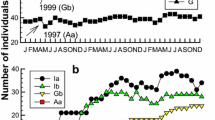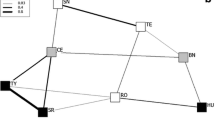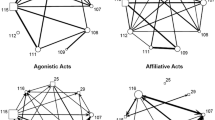Summary
Micro-and macroevolutionary effects of social group fission will be enhanced if genetic differentiation between fission products is greater than expected by randomly dividing a parent group. There is evidence that division along lines of maternal relatedness produces such an enhanced effect in the provisioned colony of rhesus monkeys on Cayo Santiago Island. In contrast, the genetic analysis presented here of group fission in a wild population of rheusus monkeys in the Himalyan foothills of northern Pakistan shows no ‘matrilineal effect’. There is a greater than 70% chance of obtaining the observed differences between fission products by random fissioning alone (Fig. 1).
The differing consequences of fission between these two populations are most likely the results of differences in their demographic structure and patterns of paternity. Under conditions of rapid population growth, diffuse paternity and clear genetic differences between matrilines, the division of social groups along lines of maternal relatedness should have the greatest genetic effects. When populations are growing slowly and groups are composed of many small matrilines or when restricted paternity prevails the genetic consequences of matrilineal fission should be no different from those resulting from random group division.
Fission with and without a matrilineal effect probably occurs at different points in the evolutionary history of a primate population. In either case the fission process usually accelerates subpopulational differentiation beyond the rate expected by drift alone and may yet prove most important in understanding the genetic structure of many mammalian populations.
Similar content being viewed by others
References
Altmann J (1979) Age cohorts as paternal sibships. Behav Ecol Sociobiol 6:161–164
Altmann J (1980) Babbon mothers and infants. Harvard University Press, Cambridge (Massachusetts)
Altmann SA, Altmann J (1979) Demographic constraints on behavior and social organization. In: Smith, EO, Bernstein IS (eds) Ecological influences on social organization. Garland, New York, pp 47–64
Bush GL, Case SM, Wilson AC, Patton JL (1977) Rapid speciation and chromosomal evolution in mammals. Proc Natl Acad Sci USA 74:3942–3946
Carpenter CR (1972) Breeding colonies of macaques and gibbons of Santiago Island Puerto Rico. In: Beveredge WI (ed) Breeding primates. Karger, Basel, pp. 223–230
Cavalli-Sforza LL (1969) Human diversity. Proc XII Int Congr Genet 3:405–416
Cavalli-Sforza LL, Edwards AWF (1967) Phylogenetic analysis: models and estimation procedures Am J Hum Genet 19:233–257
Chepko-Sade BD (1974) Division of group F on Cayo Santiago. Am J Phys Anthropol 41:472
Chepko-Sade BD, Olivier TJ (1979) Coefficient of genetic relationship and the probability of intragenealogical fission in Macaca mulatta. Behav Ecol Sociobiol 5:263–278
Chepko-Sade BD, Sade DS (1979) Patterns of group splitting within matrilineal kinship groups. Behav Ecol Sociobiol 5:67–86
Cheverud JM, Buettner-Janusch J, Sade DS (1978) Social group fission and the origin of intergroup genetic defferentiation among the rhesus monkeys of Cayo Santiago. Am J Phys Anthropol 49:449–456
Duggleby CR (1977) Blood group antigens and the population genetics of Macaca mulatta on Cayo Santiago. II. Effects of social group division. Yearb Phys Anthropol 20:263–271
Fisher RA (1960) The design of experiments. Oliver and Boyd, Edinburgh
Fix AG (1978) The role of kin-structured migration in genetic microdifferentiation. Ann Hum Genet (Lond) 41:329–339
Furuya Y (1968) On the fission of troops of Japanese monkeys. Primates 9:323–349
Furuya Y (1969) On the fission of troops of Japanese monkeys (Part II). Primates 10:47–60
Goodman M, Wolf RC (1963) Inheritance of serum transferrins in rhesus monkeys. Nature 197:1128
Kidd KK, Cavalli-Sforza LL (1974) The role of genetic drift in the differentiation of Icelandic and Norwegian cattle. Evolution 28:381–395
McMillan C, Duggleby C (1981) Interlineage genetic differentiation among rhesus macaques on Cayo Santiago. Am J Phys Anthropol 56:305–312
Melnick DJ (1981) Microevolution in a population of Himalayan Rhesus monkeys (Macaca mulatta). PhD dissertation, Yale University
Melnick DJ, Kidd KK (1981) Social group fission and paternal relatedness. Am J Primatol 1:333–334
Nash LT (1976) Troop fission in free-ranging babbons in the Gombe Stream National Park, Tanzania. Am J Phys Anthropol 48:63–77
Neel JV (1967) The genetic structure of primitive human populations. Jpn J Hum Genet 12:1–16
Neel JV, Salzano FM (1967) Further studies of the Xavante Indians. X. Some hypotheses-generalizations resulting from these studies. Am J Hum Genet 19:554–574
Ober CL (1979) Demography and microevolution on Cayo Santiago. PhD dissertation, Northwestern University
Ober CL Buettner-Janusch J, Olivier TJ (1979) Genetic differentiation between matrilines in the Cayo Santiago macaque groups. Am J Phys Anthropol 50:468
Olivier TJ, Ober CL, Buettner-Janusch J (1978) Genetics of group fissions on Cayo Santiago. Am J Phys Anthropol 48:424
Olivier TJ, Ober CL, Buettner-Janusch J, Sade DS (1981) Genetic differentiation among matrilines in social groups of rhesus monkeys. Behav Ecol Sociobiol 8:279–285
Sade DS (1972) A longitudinal study of social behavior of rheusus monkeys. In: Tuttle R (ed) Functional and evolutionary biology of primates. Aldine, Chicago
Shotake T (1979) Serum albumin and erythrocyte adenosine deaminase polymorphisms in Asian macaques with special reference to taxonomic relationships among Macaca assamensis, M. radiata, and M. mulatta. Primates 20:443–451
Smouse PE, Vitzthum VJ, Neel JV (1981) The impact of random and lineal fission on the genetic divergence of small human groups: a case study among the Yanomama. Genetics 98:179–197
Sokal RR, Rohlf FJ (1969) Biometry. Freeman, San Franccisco
Southwick CH, Beg MA, Siddiqi MR (1965) Rhesus monkeys in North India. In: DeVore I (ed) Primate behavior. Holt, Rinehart and Winston, New York, pp 111–159
Templeton AR (1979) The unit of selection in Drosophila mercatorum. II. Genetic revolution and the origin of coadapted genomes in partheno-genetic strains. Genetics 92:1265–1282
Templeton AR (1980) The theory of speciation via the founder principle. Genetics 94:1011–1038
Vandeberg JL, Stone WH (1978) Biochemical genetics of macaques. II. Glucose-phosphate isomerase polymorphism in rhesus monkeys. Biochem Genet 16:691–694
Wahlund S (1928) Zusammensetzung von Populationen und Korrelationserscheinungen vom Standpunkt der Vererbungslehre aus betrachtet. Hereditas 11:65–106
Wilson AC, Bush GL, Case SM, King MC (1975) Social structuring of mammalian populations and the rate of chromosomal evolution. Proc Natl Acad Sci USA 72:5061–5065
Wright S (1943) Isolation by distance. Genetics 28:114–138
Author information
Authors and Affiliations
Rights and permissions
About this article
Cite this article
Melnick, D.J., Kidd, K.K. The genetic consequences of social group fission in a wild population of rhesus monkeys (Macaca mulatta). Behav Ecol Sociobiol 12, 229–236 (1983). https://doi.org/10.1007/BF00290775
Received:
Accepted:
Issue Date:
DOI: https://doi.org/10.1007/BF00290775




